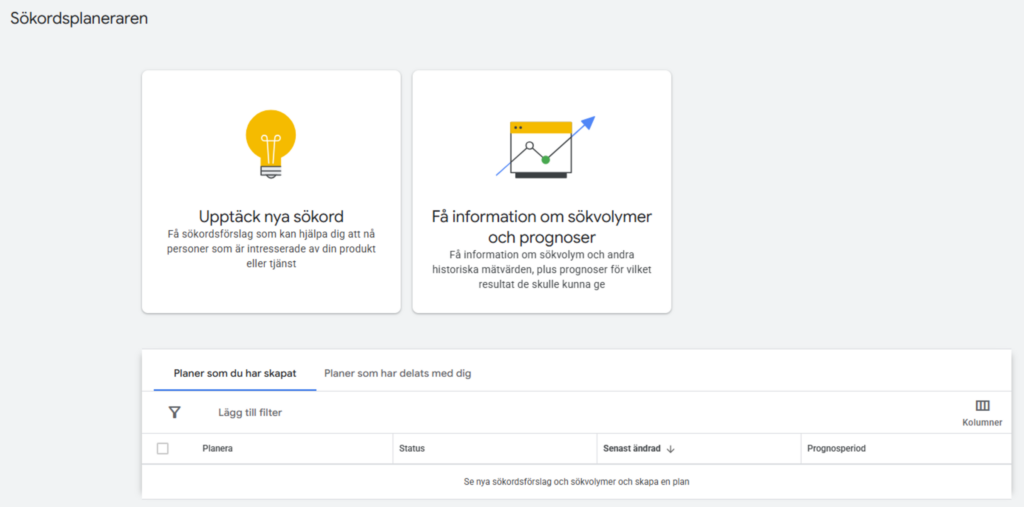Keyword analysis
Choosing the right keywords is almost always an ongoing process rather than a one-time task. Every SEO project needs a starting point, but the keyword analysis should always be adapted to the current situation. In completely new SEO projects, certain information is often missing in the beginning. For example, a particular product with good margins might turn out to sell well, even though you didn’t anticipate it. Just like in paid advertising, where campaigns are continuously updated, SEO work can also be refined over time—just not as quickly.
The Keyword Planner is a great starting point. Over the years, it has had many names and slightly different functions. Essentially, it’s a tool designed for advertisers, but it works just as well for SEO purposes.
What the Keyword Planner does is provide search volumes—how many people search for a specific term each month, sometimes shown as an annual trend chart.
Using the Keyword Planner
To use the Keyword Planner, you need a Google Ads account. This requirement has varied over the years, but at the time of writing, it’s necessary. You don’t need to spend any money, but you do need an account, which can easily be linked to your existing Google account if you have one.

How to get started
There are many ways to determine which keywords to start researching. Personally, I like to begin with a list of words I already know are relevant to the site. For an online store, I might start by selecting a few keywords for the homepage. It’s best to think broadly at first. For example, for a bicycle shop, I might begin with bicycles and cycling. By entering these into the Keyword Planner, I not only get search volume data but also suggestions for related terms that Google considers relevant.
Research related keywords
Once I have this data, I can refine it further to find more specific and potentially valuable keywords. Phrases like used bikes or bikes online might be particularly relevant, and I can enter those as well to see the results. At this stage, the goal is to collect information rather than exclude terms. Of course, irrelevant keywords can be skipped—for instance, if I sell bicycles in a specific town, keywords mentioning other cities aren’t as useful.
When you’ve gathered a list of promising keywords with reasonable search volumes, the next step is to move on to other sections of your website. For an online store, that often means category pages. For a bicycle shop, I might move on to categories like mountain bikes or road bikes and repeat the process.
Choosing keywords
Search volume isn’t the only factor that determines which keywords to target. If you sell financial services, there’s no point in optimizing for Friday vibes or Lady Gaga, no matter how popular those searches are. It may sound obvious, but beginners often make the mistake of choosing keywords solely based on search volume and ignoring relevance. Relevance is absolutely essential in SEO.

Start from your product/service
You should choose keywords that accurately represent your product or service. Ideally, the keyword should describe what you offer as precisely as possible, provided that it has a reasonable search volume. In many cases, you’ll have to settle for keywords that are close enough. It’s also important to consider the intent behind the word. Continuing with the bicycle example: the keyword bike has slightly more searches than bikes, but the intent can differ. Someone searching bike might be looking for news about cycling or the sport itself, whereas bikes more clearly indicates purchase intent.
Similarly, slalom could mean interest in the sport, while slalom skis shows a clear shopping intent.

Relevance & Intention – Extremely important
These examples illustrate relevance and intent. You need to select keywords that are relevant to your business and attract searchers who intend to engage with or buy from you. While it can be hard to predict user intent perfectly, a good starting point is to look at keywords where users explicitly indicate that they want to make a purchase, such as buy bike or cheap bikes.
If you have a limited budget or patience, it’s often smart to focus on more specific, less competitive keywords. Broad terms like bikes are valuable but also competitive. Longer phrases like buy bikes online are often easier to rank for and tend to convert better because the intent to purchase is stronger.
Competition
To conduct a realistic keyword analysis, you must consider competition and budget. If you have a small SEO budget—either in time or money—it’s often wiser to start with less competitive terms. Competing with companies that have heavily invested in top rankings can be costly and frustrating. It’s often more effective to target smaller, easier opportunities first, gain profitability, and then expand toward more competitive keywords.
Compared to larger markets like the US, SEO can actually be more challenging in smaller ones such as Sweden. There are fewer searches overall, which means fewer unique phrases—the so-called long tail is shorter. This makes competition tighter around major keywords in each industry.
Fewer total searches also mean smaller potential returns per keyword. Consequently, SEO professionals in smaller markets often work with more precision and smaller-scale tactics rather than broad, high-budget strategies common in large markets. At the same time, even niche keywords are smaller in volume than their equivalents abroad.
In many ways, competition in Sweden is actually higher—not because companies spend more, but because they compete for a smaller slice of the pie. Still, the level of SEO expertise in Sweden compares well internationally. Despite—or perhaps because of—this tougher environment, Swedish SEO is highly advanced.
Intent
Google frequently talks about search intent in its own documentation. In their Quality Rater Guidelines—an internal document for human evaluators—they classify intent into four categories: Know, Do, Website, and Visit-in-person.